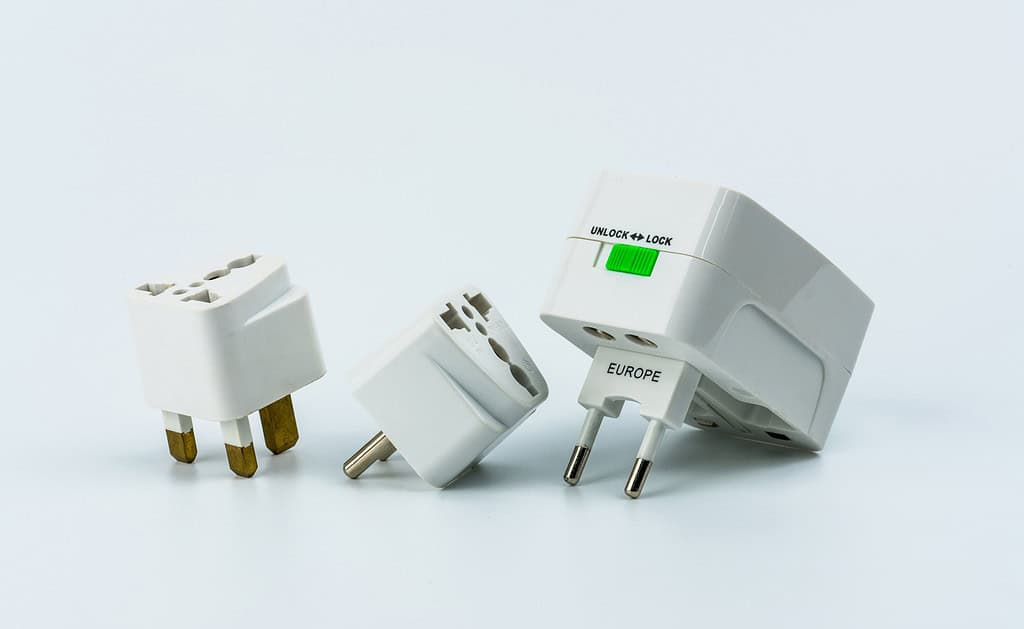
*Note some of the links feature affiliate links. I only recommend items that I 100% love and think you will too!
Did you know that there are over 15 different plug types used around the world? With unique shapes, sizes, voltages, and frequencies, navigating international power sources can be confusing for travelers. But having the right travel adapter can make all the difference in keeping your devices powered up and ready to use, no matter where your travels take you.
In this guide, we’ll walk through the key factors to consider when selecting the best travel adapter for Europe. We’ll compare the different plug types and voltages used across the continent. We’ll also provide top picks for the most convenient, compatible, and safest adapters to equip you for European travel. With the right adapter, you can avoid fried gadgets or devices left useless without a charge. Let’s explore how to keep your tech energized and ready to make the most of your Eurotrip!
Different Plug Types
Europe uses different plug and outlet types than in North America. The main types of plugs used are:
- Type C – Also known as the standard “Europlug”. It has two round pins and is used in most of Europe. The plug is unearthed and only suitable for small appliances under 16 Amps.
- Type E – This plug has two round pins and a hole for the socket’s male earth pin. The Type E plug is earthed and rated up to 16 Amps. It’s commonly used in France, Germany, Poland, Slovakia, the Czech Republic and some other central European countries.
- Type F – Also called “Schuko”. The Type F plug has two round pins and two earth clips on the sides. It is earthed and can handle up to 16 Amps. The Type F is the most popular plug type in Europe and works in all Type E and Type F outlets. It’s used in all continental European countries, except Switzerland.
So in summary – Type C is the smallest unearthed Europlug, Type E adds earthing and is used in central Europe, while Type F adds side earth clips and is compatible with Type E and F outlets, making it the most versatile option. Travellers should use adapters allowing Type C, E and F plugs for maximum compatibility.
Voltage Differences
Most countries in Europe operate on 220-240 volt electricity, while North America uses 110-120 volts. This means that North American devices are not compatible with European electrical outlets without a voltage converter. Plugging a 110-120 volt device into a 220-240 volt outlet can irreparably damage the device.
Travel adapters allow you to plug in North American-style plugs into European outlets, but they do not convert voltage. To use hair dryers, curling irons, and other high-wattage devices abroad, you’ll need a special power converter that can safely transform the 220-240 volts to 110-120 volts. Note that low-watt devices like phone chargers and laptop adapters are often designed for dual voltages, so check your device to see if it can handle 220-240 volts before using a converter.
When shopping for a travel adapter, check if it includes a built-in voltage converter. If you plan on using high-watt devices, choose an adapter with an integrated converter to avoid having to pack multiple bulky devices. Going converter-free is an option for minimalist travelers who are only charging small electronics. Just be sure to verify your device’s voltage compatibility before plugging it in to avoid a fried phone or laptop!
Key Features to Look for in a Travel Adapter
When selecting a travel adapter for Europe, there are several key features to consider:
Voltage and Wattage Capacity
- Make sure the adapter can handle the standard European voltage of 220-240V. Many quality adapters can handle from 100-250V to cover most countries.
- Check the wattage rating as well. Look for at least 2000-3000W capacity to handle charging laptops, phones, and other devices.
Number of Ports
- More ports allow you to charge multiple devices at once. 2-3 ports is standard but some adapters offer 4-6 ports.
- Look for a mix of USB and AC outlets for maximum flexibility. USB ports are great for phones/tablets while AC outlets are needed for laptops and hair dryers.
Surge Protection
- Adapters with surge protectors or fuses can protect your devices from power spikes. This provides an extra layer of safety for your electronics.
Design
- Compact and lightweight adapters are ideal for travel. Look for foldable plugs and accessories bags.
- If the adapter has a cord, ensure it’s long enough to reach distant outlets. Retractable cords are convenient.
- Some adapters have interchangeable plugs to use across regions. This allows one adapter to work globally.
Top Picks
Travel Adapter by Ceptics
The Ceptics Travel Adapter is a top choice for traveling in Europe. It can convert to multiple plug types used across Europe, including plugs for the UK, EU, and Switzerland.
Pros:
- Supports input voltages from 100V – 250V, making it versatile for use worldwide.
- Includes USB ports to charge devices.
- Compact design.
- Affordable price.
Cons:
- Only has 2 USB ports, less than some competitors.
- Doesn’t have a built-in surge protector.
 Buy Now →
Buy Now → European Adapter by OREI
The OREI European Adapter handles all common European plug types.
Pros:
- Works in over 150 countries.
- Built-in safety shutter protects from electrocution.
- Affordable price point.
Cons:
- Bulky design.
- No USB charging ports.
 Buy Now →
Buy Now → World Adapter by Ceptics
This universal adapter from Ceptics can handle electrical outlets in over 160 countries.
Pros:
- Broad compatibility worldwide.
- Includes both USB and USB-C for device charging.
- Compact and lightweight.
Cons:
- More expensive than basic Europe-only adapters.
- Doesn’t have a voltage converter.
 Buy Now →
Buy Now → Using Adapters Safely
When using a travel adapter, safety should always come first. Here are some tips to keep in mind:
- Check the voltage and amperage rating of your devices and make sure they are compatible with the local electrical system. Plugging a device designed for a lower voltage into a higher voltage outlet can damage the device.
- Don’t overload outlets. Be aware of the total wattage you are plugging into each outlet and don’t exceed the rating. Overloading an outlet with too many devices can cause overheating and start a fire.
- Make sure plugs fit snugly into outlets. Loose connections can cause sparks, shocks or fires.
- Don’t leave adapters plugged in when not in use. Unplug your adapter when it’s not connected to any devices.
- Avoid cheap, poorly made adapters. Spend a little more for a quality, safety certified adapter. Look for fused models for overload protection.
- Never force a plug into an outlet if it doesn’t fit. Make sure you have the right adapter for the country’s outlets. Forcing a plug can break the outlet and cause electrocution.
- Unplug devices before changing plugs or removing the adapter. This prevents electric shocks.
- Never touch exposed prongs or internal electronics. If your adapter becomes damaged, stop using it. The exposed wiring can electrocute you.
By following these basic safety precautions, you can avoid electrical hazards and safely use adapters when traveling internationally. Don’t take risks to save a little money on a cheap adapter. Invest in a quality adapter and use it properly.
Other Considerations
When selecting best travel adapter for Europe, there are a few other factors to keep in mind beyond plug types and voltage.
Using USB Ports
Many travel adapters today come with built-in USB ports. This allows you to charge or power USB devices like phones, tablets, speakers, and more. Having a travel adapter with USB ports means you don’t need to bring extra chargers for all your devices. Just plug them into the USB ports on the adapter.
Look for an adapter with at least two USB ports. The more ports, the more devices you can charge at once. Also, pay attention to the power output of the USB ports. Most provide 2.4 amps which is enough to charge phones and tablets at normal speed. If you need to charge larger devices like laptops, look for USB ports with higher power output.
Converters vs Just Adapters
Another consideration is whether for selecting the best travel adapter for Europe us that you need an adapter with a voltage converter built-in. An adapter by itself simply changes the shape and pins of the plug to match the wall outlet. A converter actually transforms the 220-240 volt electricity in Europe down to 110-120 volts that U.S. devices are designed for.
Most modern electronics like laptops, phone chargers, cameras, etc. are dual voltage and work on both 110 and 220-240 volts. For these devices, you just need a simple adapter without a converter. Check your device to confirm the input voltage range.
For devices that only work on 110-120 volts like hair dryers, curling irons, and older electronics, you’ll need an adapter with an integrated voltage converter. Just be aware converters can be bulkier, pricier, and tend to convert less wattage which may not work for high-powered devices.
Summary
When traveling to Europe, having the right power adapter is crucial for charging your devices and appliances safely. After reviewing the different plug types, voltages, key features, and top picks, a few key takeaways emerge:
- The plug types in Europe vary by country, with C, E, and F being the most common. Having an adapter that handles all three will ensure you can plug in across Europe.
- Pay attention to the input and output voltage range of any adapter. Europe generally uses 230V compared to 110V in North America. Make sure your adapter can handle both.
- Look for safety features like surge protection, fuse, and overload protection. Avoid cheap adapters that lack these.
- Top-rated adapters include the Pac2Go Universal Adapter for handling all plug types and voltages, the Ceptics World Plug for design and portability, and the OREI Europe Adapter for value and versatility.
- Always check the amperage rating and don’t overload the adapter. Be cautious with hair dryers and other high-wattage devices.
The right adapter makes international travel far easier. With an understanding of your needs and the top options available, finding one that fits your situation in Europe or elsewhere will be much simpler.
FAQs
What types of plugs are used in Europe?
The most common plug types in Europe are Type C (standard in most of Europe), Type F (standard in most of Europe, Switzerland, Poland), and Type L (Italy, Corsica, Europe). Type E and Type K are also used in some parts.
What voltage is used in Europe?
The standard voltage in most European countries is between 220V and 240V. This is higher than the 110-120V used in North America, so most North American devices will need a voltage converter in addition to an adapter.
Do I need an adapter if my device says it handles 100-240 volts?
Even if your device handles a range of voltages, you will still need a plug adapter to physically fit the sockets used in Europe. The adapter changes the prongs and shape but does not change the voltage.
Should I get an all-in-one adapter?
All-in-one adapters that handle multiple plug/voltage types can be convenient but may be bulkier. Getting a dedicated European adapter is recommended for frequent or extended travel.
How do I use travel adapters safely?
Do not overload adapters with too many devices. Use grounded outlets when possible. Never force a plug into an outlet or jiggle the adapter. Make sure you have the right wattage adapter for high-draw devices like hair dryers.
What else should I consider when traveling with adapters?
Consider bringing spare adapters in case one gets lost or stops working. It can also help to have a portable multi-country adapter as a backup. Check if your devices have dual voltage capabilities to avoid needing transformers.
Conclusion
Choosing the right travel adapter for Europe can make all the difference in your travels. With so many plug types and voltages, it’s crucial to find an adapter that can handle everything Europe has to offer. The best adapters are designed for safety, compatibility, and convenience.
When making your purchase, prioritize adapters with surge protection and dual voltage capabilities. Consider extras like USB ports for charging multiple devices. Compact, lightweight designs make adapters easy to pack.
Do your homework and read reviews to find a quality product that will work across Europe’s diverse electrical systems. Purchase well before your trip so you can ensure it meets your needs. Using the wrong adapter can damage electronics or cause safety issues.
Investing in the right adapter will allow you to charge your devices securely and prevent any hiccups in your European adventure.
If you are looking for more tips on planning a trip to Europe, check out this post: Europe Travel Guide 2025: Your Complete Planning Resource for Unforgettable Adventures.
The Ultimate Travel List
Plan the perfect European adventure with tips and tools for seamless travel. Discover affordable luggage storage solutions in Madrid. Explore must-see attractions, tapas, and tips for a weekend in Madrid. Equip your kids with the best travel gear for exploring Europe. Dive into Barcelona's top bucket list experiences for an unforgettable journey.
How to Plan the Perfect Trip to Europe: Tips and Tools
Master the art of planning the perfect European adventure with our comprehensive guide, brimming with essential tips and indispensable tools to ensure a seamless and unforgettable journey.
The Best Kids Travel Gear for Europe
Equip your little explorers with the ultimate travel gear to make their European adventure comfortable, enjoyable, and memorable.
The Ultimate Guide to Europe's Summer Destinations
Embark on a journey through Europe's most enchanting summer destinations with our ultimate guide, revealing the breathtaking landscapes, cultural treasures, and unforgettable experiences awaiting your discovery.
Madrid in a Weekend: Must-See Attractions, Tapas, and Tips
Experience the essence of Madrid in just one weekend, with our guide showcasing must-see attractions, tantalizing tapas spots, and insider tips for an unforgettable city escape.
Barcelona Unplugged: Insider's Advice for Your 2024 Stay
Unlock the heart of Barcelona with insider advice tailored for your 2024 stay, guiding you through hidden gems, local hotspots, and unforgettable experiences in this vibrant Spanish city.
Guide to the Best Women's Walking Shoes for Traveling Europe
Discover the perfect pair of women's walking shoes designed for comfort, style, and durability, ensuring a seamless and enjoyable travel experience across Europe's cobblestone streets and bustling cityscapes.
The information in this article is for informational purposes only and may not reflect the most current updates; please verify details independently before making travel plans. Always check with local sources before confirming your plans.






Comments Off on The Best Travel Adapters for Europe